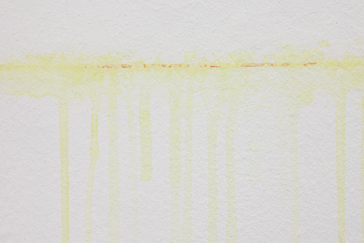
Born in 1974 in El Khnansa (MA)
Lives and works in Paris (FR) and Martigny (CH)

2010
Synthetic food coloring
Dimensions variables, installation à 1,66 m du sol
Year of Purchase: 2011
“Let’s race to the horizon, fast, run fast, it’s late;
Let’s catch at least one slanting beam before tomorrow!” 0
“The food coloring Gaya will bring to your sauces, seasonings, and gravies the color of the Mediterranean.” 01
“In them everything is departure, becoming, passage, leap, daemon, relationship with the outside." 02
The installation Gaya (E102) Horizon 3 created in 2010 on the occasion of Latifa Echakhch’s solo exhibition Le rappel des oiseaux at FRAC Champagne-Ardenne inspired many interpretations—an intellectual and sensual play of constructions and deconstructions. By questioning collective and individual identity, culture, and history, the artist explores all the meanings, and senses of the world, with a very contemporary “suggestive magic that contains both the object and the subject, the outside world and the artist [her]self.” 1
Of Moroccan origin, but living in Paris and Switzerland, Latifa Echakhch does not identify herself with the Arab culture, and turns away from the exoticism that is both expected and derided, without, however, denying her personal history. Gaya (E102) Horizon 3 draws a line under the “white cube,” and with a discreet gesture opens a new field for reflection and a sets the stage for a play of displacements of the viewer’s gaze. The landscape is thus both what is seen and what is experienced, here and beyond.
Gaya (E102) Horizon 3 2 is an in-situ work composed of a brown-and-purple line traced along all the walls of the exhibition room, 1.66 meters above the floor. Partly washed out by a spray of water, the line runs along the entire circumference of the room: a panoramic, seminal line with pale yellow liquid streaking from the trace. One imagines a horizon welling up with tears. The straight line is here the shortest road to a false trail.
Horizon is a construction of the mind, a figure in the landscape, a primary structure of representation, a symbolic chimaera. Here, it crystallizes a certain number of issues in the work of Latifa Echakhch. Horizon is the natural site—a non-place, a void where the landscape totters and where humans lose sight of the world; it’s a void which they must overcome. The lyricism of the Romantic landscape depicts the horizon as a symbol of the duality of man torn between his belonging to the earth and his dream of Icarus, between the field of existence and the place of otherness and desire. Echakhch’s installation shows a familiar, receding, artificial horizon. The level of 1.66 meters, corresponding to the height of the artist, inscribes the presence of an absent body—that of the artist who loves to haunt her own works as a ghost.
There is a semantic and physical shift from the “coloring” to the “color,” from artistic endeavor to earning a living, a sort of “Concrete Art of the kitchen.” Gaya is a Moroccan brand of food coloring which can also be found in Arab grocery stores in France, as well as in the pantries of families such as Echakhch’s. The substance E102 is a non-artistic substance and an exotic artifact, a water-soluble food dye often used in popular Middle-Eastern dishes and in Asian cuisine as an affordable substitute for saffron. As the “most expensive spice in the world,” saffron is the object of counterfeiting and forgery, just like a work of art. The insipid Gaya E102 fake is only used to obtain a “stylistic effect”: it dyes the food in order to make it visually more “fit” for consumption. The question of aesthetic judgment—judgment of taste—is here an aesthetic/cosmetic appropriation of an everyday object. The Tartrazine in Gaya E102 may produce possible side effects such as hyperactivity, asthma, skin and nasal allergic reactions, disturbances in vision, insomnia, cancer with mutagenic and teratogenic effects, attention deficit disorders and behavioral disorders in children, and even autoimmune diseases. As Gaya (E102) Horizon 3 is a “passage from one place to another,” which is the definition of the Latin word “migratio,” perhaps these side-effects are produced by all the utopias of exile and illusory freedom of the birds.
We’ve thus made a tour of the horizon.
Luc Jeand’heur
0 Charles Baudelaire, “Setting of the Romantic Sun” in: The Flowers of Evil (1857), trans. William H. Crosby.
01 An ad for Gaya
02 Gilles Deleuze, Claire Parnet, Dialogues, 1996 (trans. Hugh Tomlinson and Barbara Habberjam).
1 Baudelaire, L’Art philosophique, 1859.
2 Element in a series that could be entitled Gaya (E102) where it also plays the roles of “stained glass,” traces drawn with the tongue on a canvas, “fountain”…